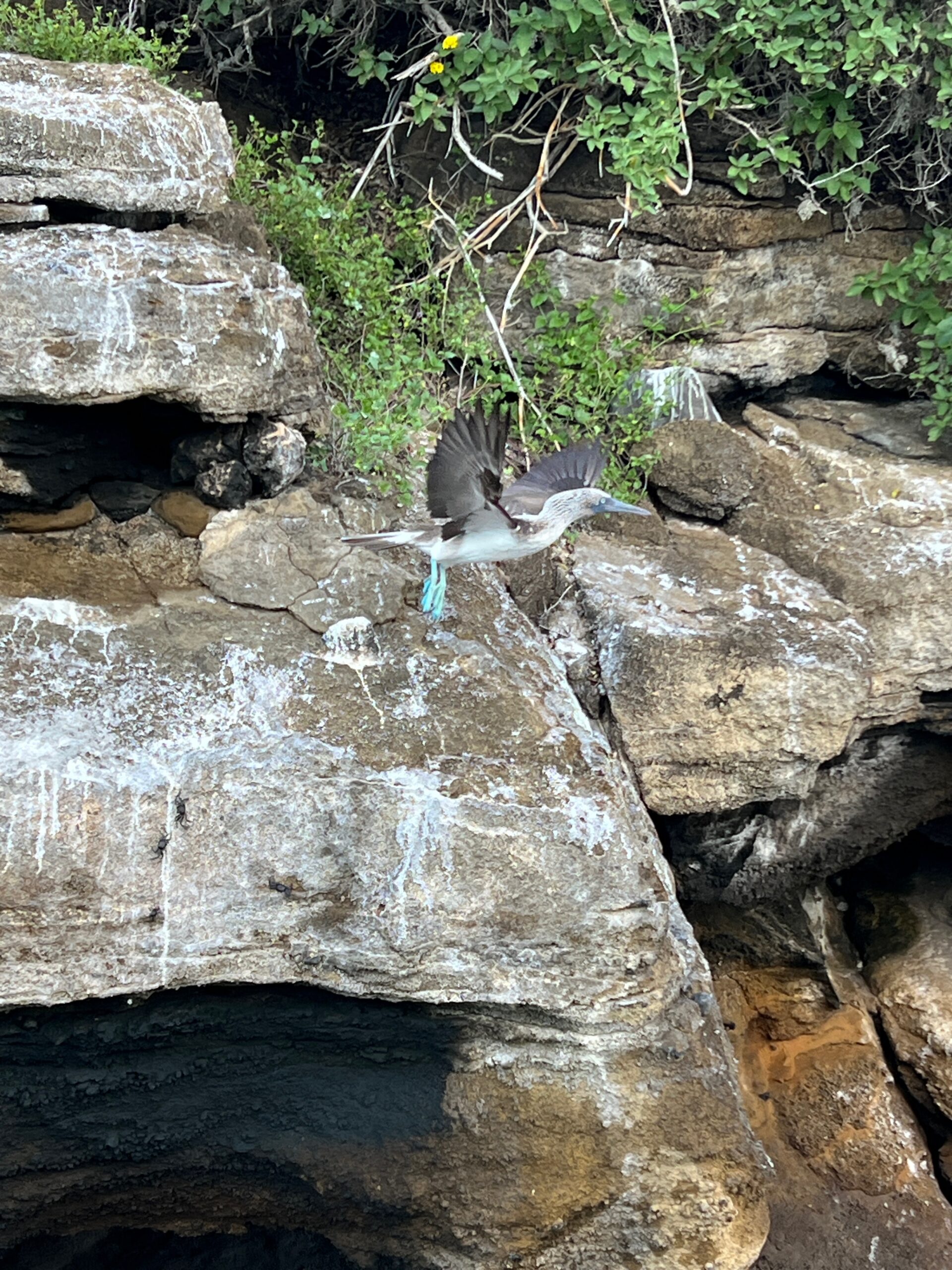Our next stop was on the island of Floreana, a beach landing with a walk to an inland lagoon with pink flamingos! This was the first time I’d ever seen flamingos in the wild. Or a frigate bird perched on a tree; I’ve only seen them soaring overhead. Steve and I got buzzed by a flying male frigate in mating mode with his puffed up red breast. What a sight. And this was also our first up close look at the blue-footed boobies, which turned out to be my favorites. Their feet should be a Pantone color of the year. We also saw heron – a great blue and a yellow crowned night heron, the former along side a very lackadaisical sea lion. And the Sally Lightfoot crabs with their brilliant red color were everywhere. The immature crabs are very dark and blend right in with the wet rock, a very effective form of camouflage.
We were able to snorkel a bit more at this stop, and it is evident why the boobies and heron stick close. Anchovies! And lots of them, in schools that glitter in the sunlight. Parrotfish and gar were also in evidence.
In the afternoon we made a landing at Post Office Bay, a spot on Floreana with an historic past. On the tender ride in we saw one of the many feral cats on the island, along with the requisite sea lion and a booby or two. According to The Happy Gringo website the Post Office Bay legend goes like this:
Whaling ships would spend years at sea, hunting whales to turn into valuable oil. It was a lonely and tough life for sure, never knowing when you might next see your loved ones back home So the sailors devised an ingenious method of communication. They set-up their own whalers’ post office at a point where they knew ships would frequently pass through: the Galapagos Islands.
As the legend tells it, in 1793 they left a wooden whiskey barrel on Floreana Island. The system was simple: any passing sailor could leave a letter there, but he also had to check if there was any mail that he might be able to deliver himself when he returned home. For example, a sailor who was finishing his journey in London, England would take any mail with a London address. When he finally reached port he was then responsible to deliver it. Bearing in mind that whalers could spend two years or more at sea, this was a very slow mailing system – sometimes letters were delivered more than a year after written. But it was a simple system, and it worked for centuries.
Floreana was a logical choice for the post office. It was already a popular Galapagos stop to load up on provisions of fresh water and food. Floreana is home to one of the few fresh water sources of the whole archipelago, and also had a bountiful supply of fresh meat in the form of giant tortoises. In fact this pit-stop was so popular that the Floreana tortoise was eventually hunted to extinction.
The original whisky barrel is no longer here, but the post office bay tradition lives on. Tourists can participate in the post office bay custom, and are encouraged to leave their own postcards. No stamp is required, just a clearly written address, and a little blind faith.
Visitors should also have a rummage around the postcards in the modern day barrel. If you spot an address close to your hometown then take it away with you. Just remember the honor system when you get home – it is a big responsibility to deliver the letter or postcard to the addressee. More than that, the mail should be delivered by hand. Tour guides are known to say that slapping a stamp on the letter and dropping it in a mailbox is cheating.
Steve and I did indeed leave a few postcards, and one was already delivered to the UK but the traveler cheated and put a stamp on it and threw it in the mail. We also picked up a few cards with Providence, RI addresses that we plan to hand deliver if we can. They look like college addresses so if they were “posted” over a year ago the recipients may have since moved on. But we will indeed try. I love this tradition and we’re happy to try to preserve it.
The day ended with a stunning moon over a glorious sunset. Another memorable day in Galapagos.



Leave A Comment